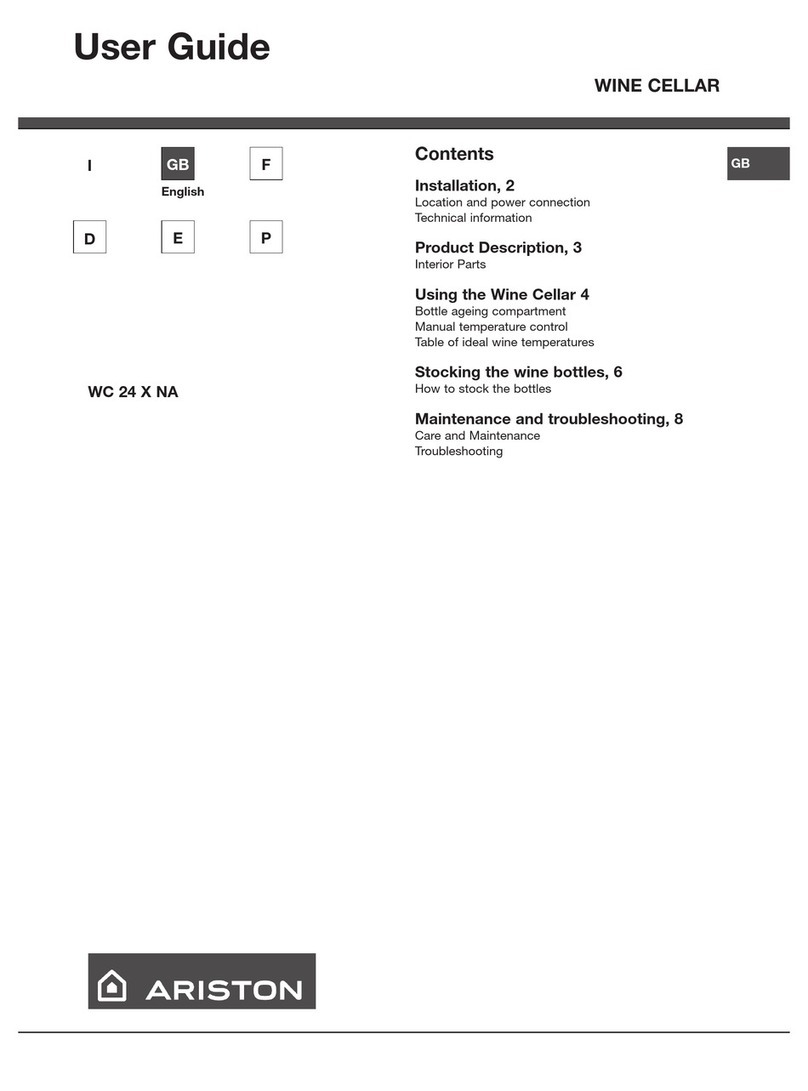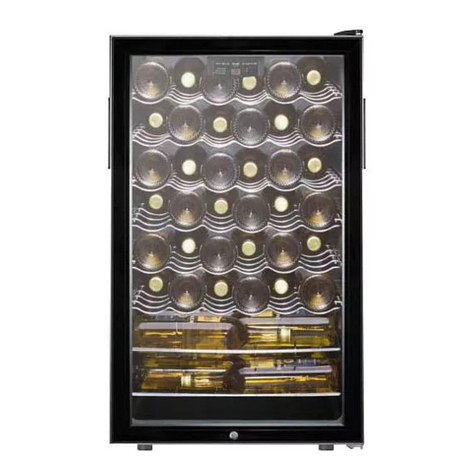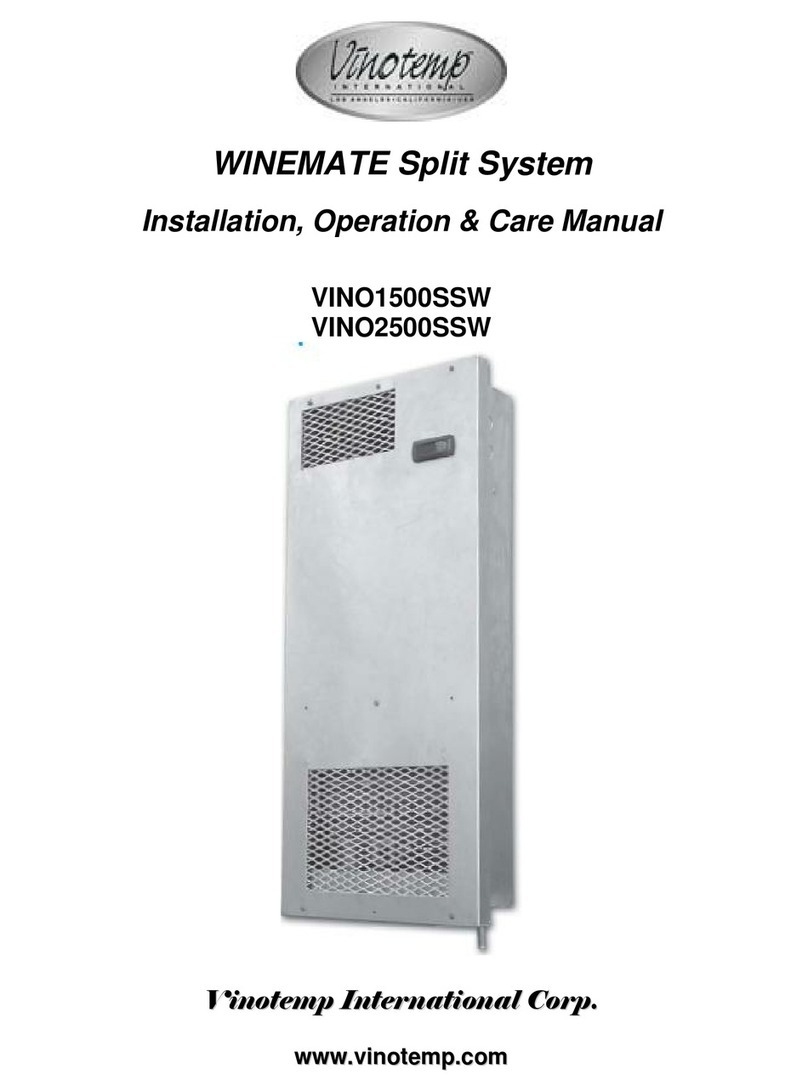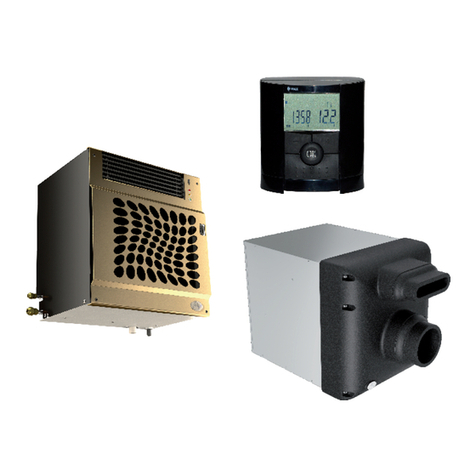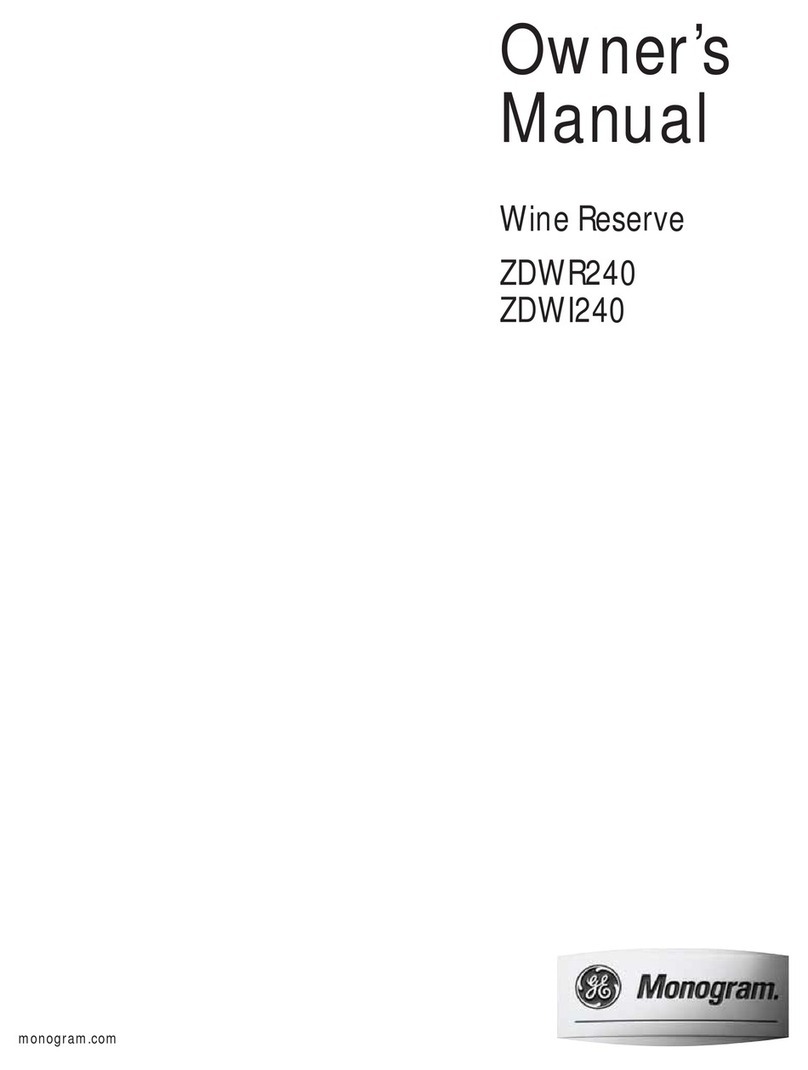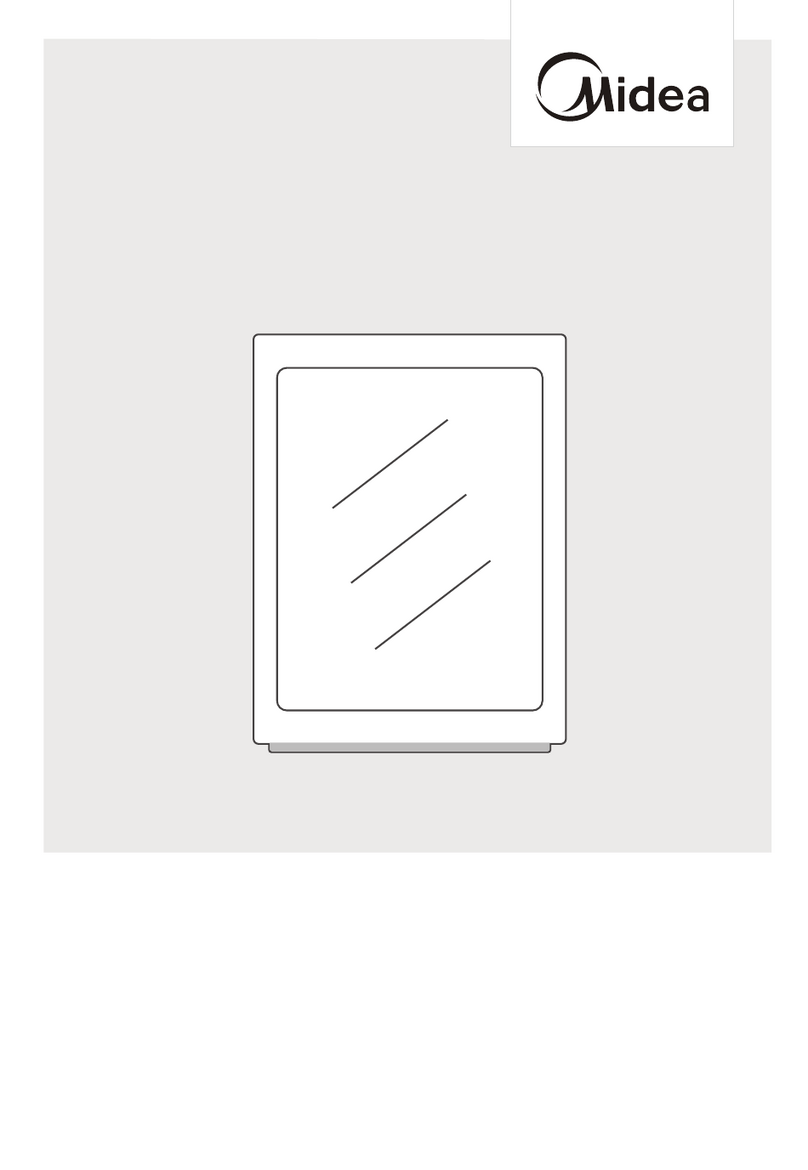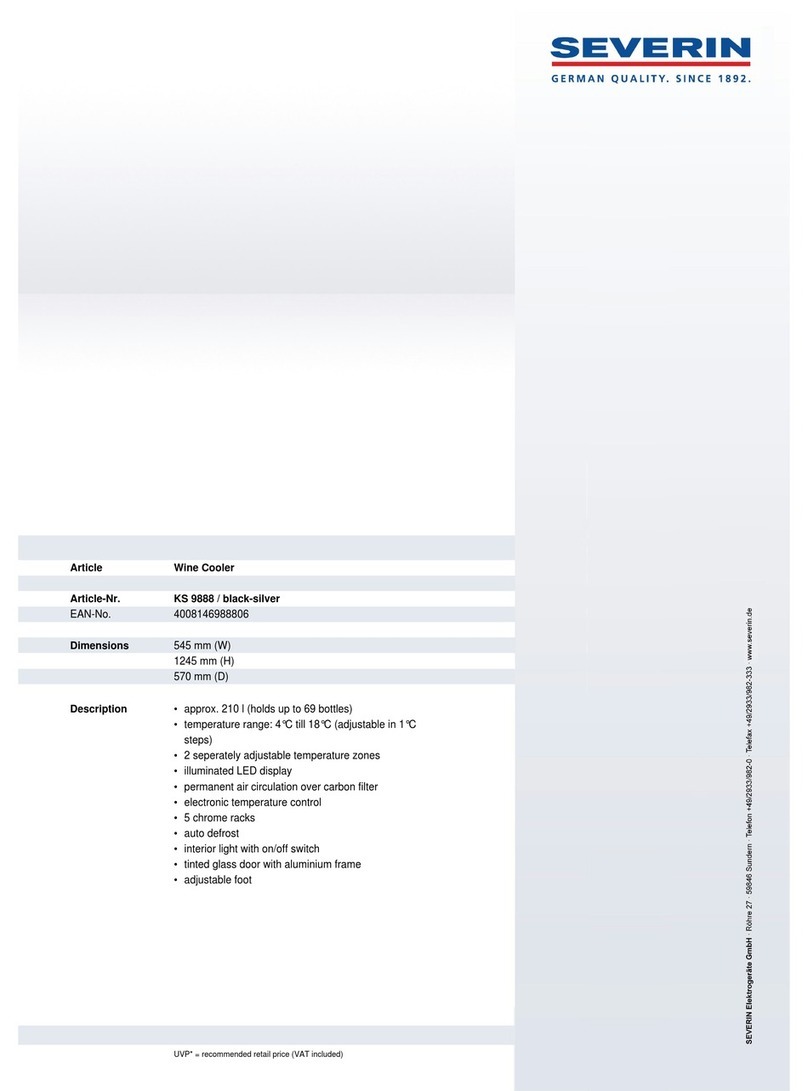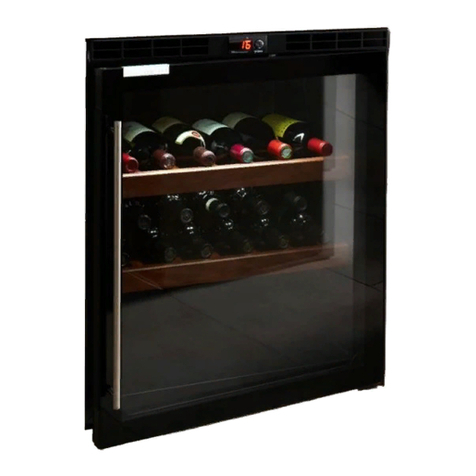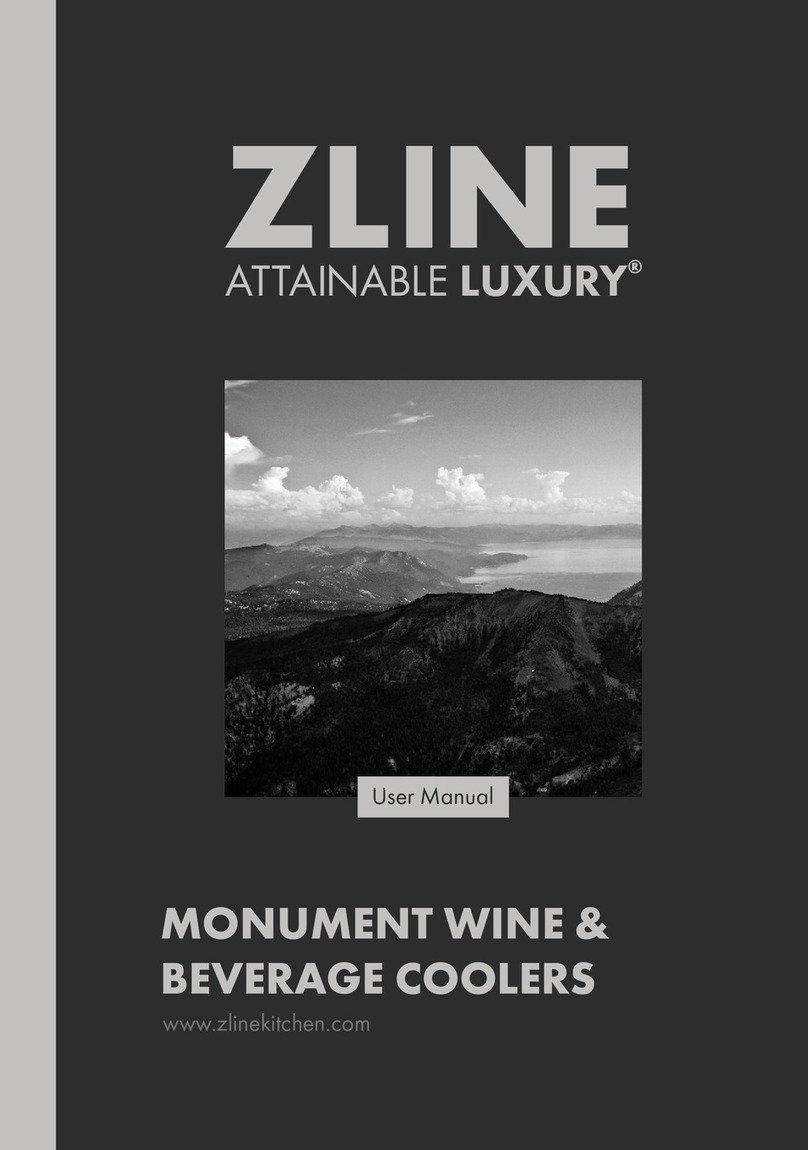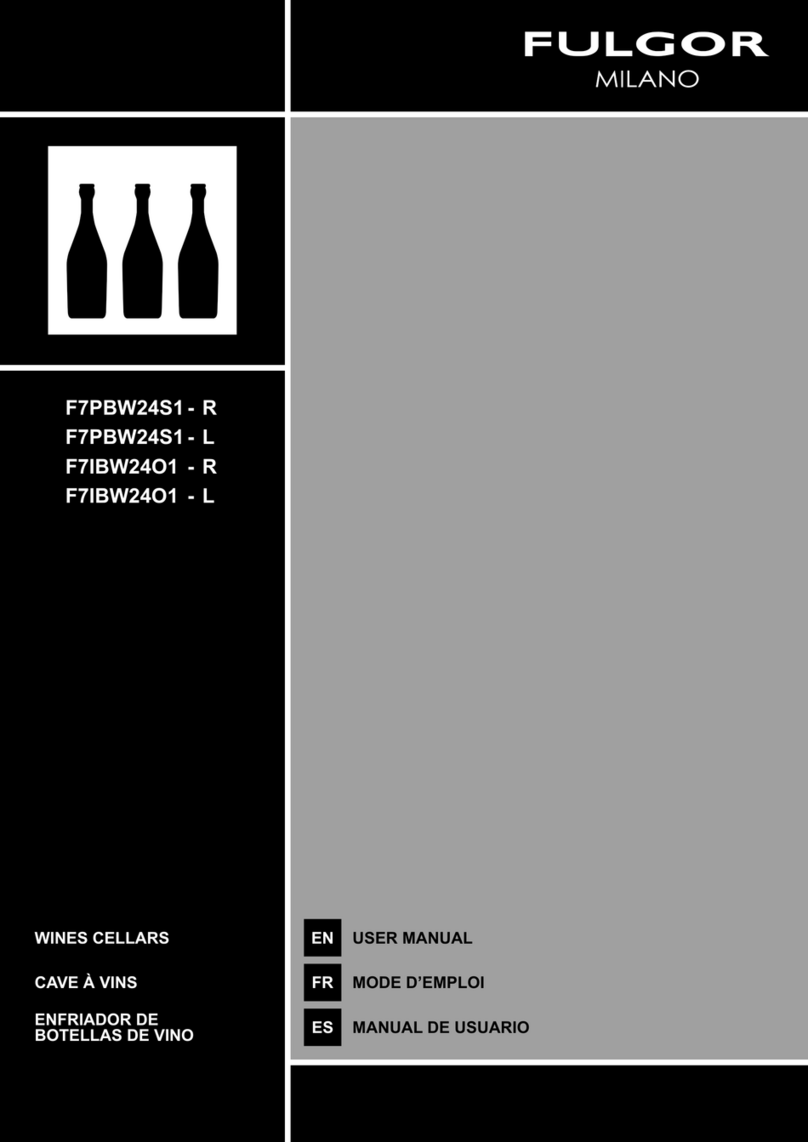Bordeaux BEWC-46 User manual

46 Bottle Dual Zone Wine Cooler
Built-in & Free Standing
Operation and Storage Manual
Model: BEWC-46

Contents
1 Features 1
2 Before First Use 1
3 Important Safety Measures and Instructions 2
4 Warnings and Cautions 3
5 Installation 6
6 Device Overview 7
7 Before Initial Operation 8
8 Temperature Setting 8
9 Operation 8
10 Helpful Hints/Energy Saving 9
11 Cleaning & Maintenance 9
12 How to Move the Appliance 10
13 How to Move the Shelves 11
14 Cabinet Dimensions 11
15 Trouble Shooting 12
16 Decommission 13
17 Electrical Circuit Diagram 13
18 Specifications 14

1
46 Bottle Dual Zone Wine Cooler
Thank you for choosing a Bordeaux Wine Cooler. If operated and taken care
of properly in accordance with these instructions, this appliance will be useful
for many years.
1 Features
• Dual zone for 16 + 30 bottles
• Upper zone 5–10°C
• Lower zone 10–18°C
• Built-in & free-standing installation
• Blue LED interior light with switch
• Tempered glass door
2 Before First Use
• Before first use, remove any stickers or similar from the appliance except for
the rating label.
• Dispose of any plastic bags as they pose a risk of suffocation to young
children.
Please read this manual before operating the appliance and keep it in a safe
place for future reference. If this appliance is transferred to a new owner, the
manual should also be provided to the new owner. If you ignore the safety
instructions, you will endanger your health and life.
• Stainless steel door frame and handle
• No frost with interior fan circulating
• Energy efficient design
• 100% HFC free and CFC free
• Security lock system
• Beech wood shelves

2
3 Important Safety Measures and Instructions
• Before operating the appliance, check if the voltage indicated on the
appliance’s technical plate corresponds to the voltage of the electricity
supplied to your home.
• Check the technical periphery of the appliance. Do all wires and connections
to the appliance work properly? Or are they time-worn and do not match
the technical requirements of the appliance? A check-up of existing and
newly made connections must be done by an authorized professional. All
connections and energy-leading components (incl. wires inside a wall) must
be checked by a qualified professional. All modifications to the electrical
mains to enable the installation of the appliance must be performed by a
qualified professional.
• This appliance is intended for private use only.
• This appliance is intended for cooling wine in a private household only.
• This appliance is for indoor use only.
• This appliance is not intended to be operated for commercial purposes,
during camping or in public transport.
• Operate the appliance in accordance with its intended use only.
• Do not allow anybody who is not familiar with this instruction manual to
operate the appliance.
• This appliance may be operated by children aged from 8 years and above
as well as by persons with reduced physical, sensory and mental capabilities
or lack of experience and knowledge if they are supervised or have been
instructed concerning the safe use of the appliance and do comprehend
the hazards involved. Children must not play with the appliance. Cleaning
and user maintenance must not be carried out by children unless they are
supervised.

3
4 Warnings and Cautions
• Do not connect the appliance to the mains if the appliance itself or the
power cord or the plug are visibly damaged.
• Never try to repair the appliance yourself. If the appliance does not operate
properly, please contact the shop you purchased the appliance at. Original
spare parts should be used only.
• When the power cord is damaged, it must be replaced by the manufacturer
or an authorized after sales service or a qualified professional only.
• This appliance is equipped with the environmentally friendly refrigerant
R600a. The refrigerant R600a is inflammable. The components of the
cooling circuit must not be damaged during transport or use.
• If any part of the cooling circuit is damaged, the appliance must not stand
near a fire, naked light or spark-generating devices. Contact the shop you
purchased the appliance at immediately.
• If gas is set free in your home:
1. Open all windows.
2. Do not unplug the appliance and do not use the control panel or
thermostat.
3. Do not touch the appliance until all the gas has gone, otherwise sparks can
be generated which will ignite the gas.
• Keep all components of the appliance away from fire and other sources of
ignition when you dispose of or decommission the appliance.
• Do not install the appliance near volatile or combustible materials (e.g. gas,
fuel, alcohol, paints) or in rooms which may have poor air circulation (e.g.
garage).
EXPLOSION HAZARD
Do not store any explosive materials or sprays that contain flammable
propellants in your appliance.
• Do not connect the appliance to the electric supply unless all packaging and
transit protectors have been removed.

4
• Operate the appliance with 220–240V AC/50Hz only. All connections and
energy-leading components must be replaced by an authorized professional.
• Do not use a socket board or a multi socket when connecting the appliance
to the mains.
• A dedicated and properly grounded socket meeting the data of the plug is
required to minimize any kind of hazard. The appliance must be grounded
properly.
• Check that the power cord is not placed under the appliance or damaged
when moving the appliance.
• The technical data of your energy supplier must meet the data on the model
plate of the appliance.
• Your domestic circuit must be equipped with an automatic circuit breaker.
• Do not modify the appliance.
RISK OF ELECTRIC SHOCK
Turn off the power before you install the appliance and before you connect
it to the mains. Do not use any steam cleaners to clean or defrost the
appliance. The steam can get into contact with the electrical parts and cause
an electrical short. Never use mechanical devices, knives or other sharp-
edged items to remove encrusted ice inside the appliance.
• Disconnect the appliance from the mains before you clean or maintain it.
• Do not use any electric appliances inside the food storage compartments of
your appliance unless they are recommended by the manufacturer of your
refrigerator.
• Do not put any heat-radiating appliances onto your appliance.
• Do not install the appliance in a place where it may come in contact with
water/rain, otherwise the insulation of the electrical system will be damaged.
• Do not put a water-boiler or vases onto your appliance. The electrical
components of your appliance can be seriously damaged by water over-
boiling or spilled water.

5
• Children must never play with the appliance.
• If you decommission your appliance (even temporarily), ensure that children
cannot get into the appliance.
• The condenser and the compressor, located at the rear of the appliance, can
reach high temperatures during ordinary operation. Carry out the installation
according to this manual. Insufficient ventilation of the appliance will impair
its operation and will damage the appliance. Do not cover or block the
ventilation slats at any time.
• Do not touch the extremely cooled surfaces with wet or damp hands,
because your skin may stick on these surfaces.
• When you move the appliance, hold it at its base and lift it carefully. Keep
the appliance in an upright position.
• Do not tilt the appliance more than 45°.
• If the appliance is transported in a horizontal position, some oil may flow
from the compressor into the refrigerant circuit.
• Leave the appliance in an upright position for 4–6 hours before you switch it
on to ensure that the oil has flowed back into the compressor.
• Never use the door for moving the appliance as you will damage the hinges.
• Do not operate the appliance unless all components are installed properly.
• Do not stand or lean on the base, the drawers, the doors etc of the
appliance.
• Do not put hot liquids or hot foodstuff into the appliance.
• The air vents of the appliance or its built-in structure (if the appliance is
suitable for being built-in) must be completely open, unblocked and free of
any kind of dirt.

6
5 Installation
• Unpack the appliance carefully. Dispose of the packaging.
• The accessories of your appliance can be protected from damage due
to transportation (adhesive tape etc.). Remove such tape very carefully.
Remove remains of such tape with a damp cloth using lukewarm water and a
mild detergent (see chapter Cleaning and Maintenance). Never remove any
components from the back of the appliance.
• Install the appliance in a suitable position with an adequate distance from
sources of heat and cold.
• Check that the appliance and the power cord are not damaged.
• Install the appliance in a dry and well-ventilated place.
• Protect the appliance from direct sunlight.
• The doors must open completely and without hindrance.
• Install the appliance on a level, dry, solid floor.
• Connect the appliance to the mains properly.
• The nameplate is situated inside the appliance or at the back.

7
6 Device Overview
1NTC Point
2Light
3Carbon Filter
4Fan
5Temperature Setting
6Exhaust Window
7Temperature Display
8C°/F° Switch
9Light
10 NTC Point
11 Light Switch
12 Fan
13 Shelf
14 Exhaust Window
15 Exhaust Window
16 Foot
17 Hinge
18 Glass
19 Door Seal
20 Handle
21 Hinge
22 Lock

8
7 Before Initial Operation
• Leave the appliance in an upright position for 4–6 hours before you connect
it to the mains.
• Clean the appliance thoroughly. Be very careful, especially inside the
appliance (see chapter Cleaning and Maintenance).
• The appliance must be connected to the mains properly.
• Allow the appliance to stabilize the temperature for approx. 24 h before use.
• Do not overfill the appliance.
8 Temperature Setting
• Set the temperature using the and buttons by 1° within a range of
5–10°C (40–50°F) for the upper zone, or 10–18°C (50–66°F) for the
lower zone.
• Switch on/off the internal light using the LIGHT button.
• Select degrees Celsius or degrees Fahrenheit using the °C/°F button.
• Flashing LED = Setting mode of the temperature.
• Constant LED = Cooling temperature.
9 Operation
• The appliance can only reach the relevant temperatures when:
1. The ambient temperature meets the climatic class.
2. The doors close properly.
3. You do not open the doors too often or too long.
4. The door seals are in proper condition.
5. The appliance is properly positioned.

9
6. You have not overfilled the appliance.
7. You do not store warm or hot food in the appliance.
• High ambient temperatures and simultaneously operating at the coldest
setting may make the compressor operate permanently to keep the
temperature constant inside the appliance.
10 Helpful Hints/Energy Saving
• Try opening the door as little as possible, especially when the weather is warm
and humid. When you open the door, close it as soon as possible.
• Make sure the appliance is always well-ventilated. The appliance has to be
well-ventilated from all sides.
• Disconnect the appliance from the mains if you do not operate it.
• Always keep the door seals clean and in a proper condition.
11 Cleaning & Maintenance
WARNING
Disconnect the appliance from the mains before you clean or maintain it.
• Always keep the appliance clean so that unpleasant odours do not occur.
• Dust deposits on the condenser will increase the energy consumption. Clean
the condenser twice a year with a vacuum cleaner or a soft brush.
• Take off all rings and bracelets before cleaning or maintaining the appliance,
otherwise you may damage the surface of the appliance.
Detergent
• Do not use any harsh, abrasive detergents.
• Do not use any aggressive detergents.
• Do not use any solvents.

10
External Cleaning
• Use a moist cloth and a mild, non-acid detergent.
• Use clear water to rinse.
• Dry the cleaned surfaces with a cloth.
Internal Cleaning
• Clean the shelves and the other removable parts with warm water and a mild,
non-acid detergent.
• Use clear water to rinse.
• Dry the cleaned surfaces with a cloth.
• Clean the interior with water and a mild, non-acid detergent.
• Use clear water to rinse.
• Dry the cleaned surfaces with a cloth.
• Check the water drain and clean it if needed.
Door Seal
• Clean with warm water and a mild, non-acid detergent.
12 How to Move the Appliance
• Remove all bottles.
• Securely tape down all loose items inside the appliance.
• Turn the level feet up to the base to avoid damage.
• Tape the door.
• The appliance must be moved in an upright position.

11
13 How to Move the Shelves
• Open the door completely before you pull out the shelves to avoid damaging
the door seal.
• For easy access to the storage content, pull the shelves approx. 1/3 out. A
notch on both sides of the tracks protects bottles from falling down.
• When you want to remove/insert a shelf, hold it tilted (see below):
14 Cabinet Dimensions

12
15 Trouble Shooting
POSSIBLE CAUSE MEASURE
The plug of the appliance is not
connected to the socket.
Check the corresponding socket by
connecting it with another appliance.
The plug has become loose. Check the fuse box.
• The socket is not supplied with energy.
• The fuse is switched off.
• The voltage is too low.
Compare the data on the model plate
with the data of your energy supplier.
The door was frequently opened. Close the door properly.
The door is not properly closed. Do not overfill.
• The appliance is overfilled. The door
seals are damaged.
Replace the seal.
• Main control board is defective.
• PCB is defective.
• Plug is defective.
Contact the service.
• LED is defective.
• Temperature cannot be determined.
Contact the service.
The appliance is not installed
on a level, dry, solid floor.
Realign the appliance.
Readjust the appliance.
The appliance is in contact with a
wall or another item. The bottles
are incorrectly positioned.
Realign the bottles.
Some items have dropped
behind the appliance.
Remove these items.
The appliance is not installed
on a level, dry, solid floor.
Realign the appliance.
Door seal is defective. Replace the door seal.
Shelves are not inserted properly. Insert the shelves properly.
Control panel is defective. Contact the service.

13
16 Decommission
• If the appliance is not used for a longer period of time:
1. Draw the plug out of the socket.
2. Remove all food stored in the appliance.
3. Dry the inside of the appliance with a cloth and leave the door open for a
few days.
• While away on an average vacation/holiday (14–21 days):
1. Do the same as described above, or
2. Let the appliance operate.
3. Remove all perishable food from the cooling compartment.
4. Clean the cooling compartment.
5. Freeze all food which is suitable to be frozen.
• If you want to move the appliance:
1. Secure all removable parts and the contents of the appliance. Pack them
separately if necessary.
2. Transport the appliance in an upright position only. All other positions can
cause damage to the compressor.
3. Do not damage the feet of the appliance.
17 Electrical Circuit Diagram

14
18 Specifications
Model: BEWC-46
Capacity: 138L
Climate Type: SN.N
Protection Type: I
Voltage: 220–240V AC
Frequency: 50Hz
Rated Current: 220V/1.0A
Input Power: 90W
Temperature Control Range: Upper zone: 5-10°C; Lower zone: 10-18°C
Net Weight: 47kg
Product Size (W×H×D): 59.5 x 84 x 56.8cm
Customer Support
www.asiapacbrands.com
Helpline New Zealand call toll free 0508 274 2722
Australia call +64 9 974 9206
Distributed by
Asia Pacific Brands Limited
PO Box 301145, Albany, Auckland, 0752
New Zealand
Other manuals for BEWC-46
1
Table of contents

